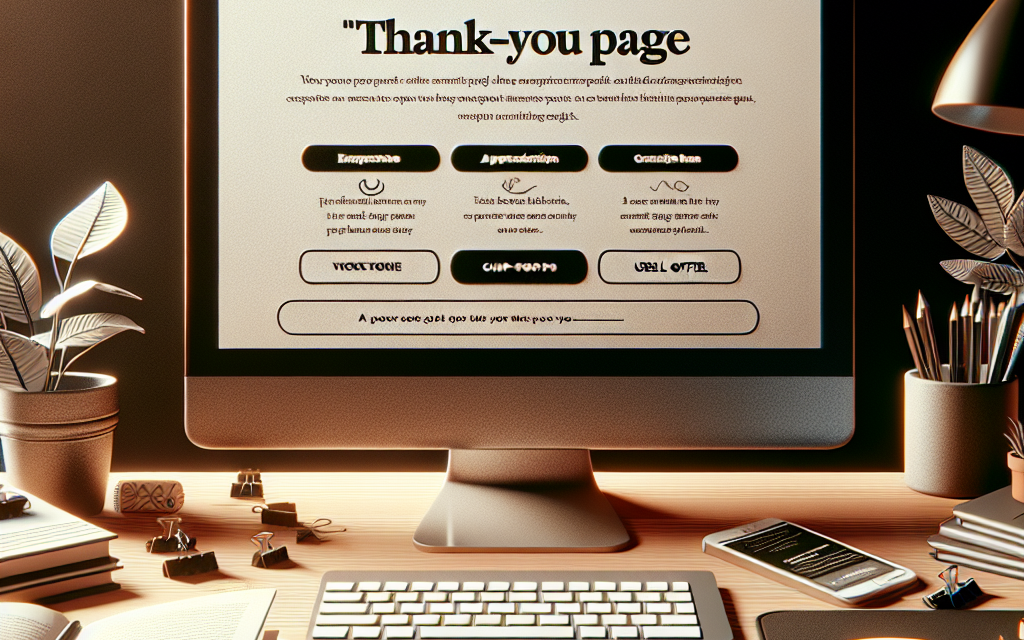Designing Thank-You Pages That Convert: A Comprehensive Guide
In the world of digital marketing, every step of the customer journey is crucial. Among these steps, the thank-you page is often overlooked. However, this small piece of real estate can have a significant impact on customer retention, further engagement, and conversion rates. In this comprehensive guide, we’ll explore how to design thank-you pages that convert and keep your visitors coming back for more.
Why Are Thank-You Pages Important?
Thank-you pages serve several critical functions:
-
Acknowledgment of Conversion: Recognizing the action taken by the user—whether it’s signing up for a newsletter, downloading a resource, or making a purchase—reinforces their decision.
-
Next Steps: They provide an excellent opportunity to guide users on what to do next, be it exploring your blog, checking out your products, or sharing on social media.
-
Building Brand Loyalty: An effective thank-you page can foster a sense of connection, keeping your brand top-of-mind for future interactions.
Key Elements of a High-Converting Thank-You Page
-
Clear Thank-You Message: Start with a simple statement thanking the user for their action. Make it personalized if possible.
-
Confirmation of Action: Clearly state what they have completed. For example, “Thank you for signing up! Check your inbox for a confirmation email.”
-
Social Proof: Adding testimonials or user experiences can help build trust and leverage the power of social proof.
-
Call to Action (CTA): Encourage further engagement. A well-placed CTA might prompt users to check out your latest blog post, follow you on social media, or access additional resources.
-
Follow-Up Incentives: Offer the user something in return, like a discount code, exclusive access to content, or a downloadable resource.
Best Practices for Designing Thank-You Pages
-
Keep It Simple: Avoid clutter. A clean and simple design will make your thank-you page more effective.
-
Match Your Brand’s Style: Consistency in design helps reinforce brand identity. Use your brand colors, logos, and fonts.
-
Mobile Responsiveness: Ensure that your thank-you page is mobile-friendly. Many users access content via their smartphones, and a great mobile experience can make or break conversions.
-
Testing and Optimization: Use A/B testing to find the elements that work best on your thank-you page. Tools like Google Analytics can help you track user behavior and optimize for better conversion rates.
Tools and Plugins for Optimizing Thank-You Pages
WordPress provides numerous tools and plugins to help you create effective thank-you pages:
-
Elementor: A powerful page builder that allows you to create custom thank-you pages without needing coding knowledge. Learn more about Elementor.
-
WooCommerce: If you’re running an online store, integrating WooCommerce can help you create dynamic thank-you pages for order confirmations. WooCommerce Documentation.
-
OptinMonster: This lead-generation software can help you turn thank-you pages into conversion powerhouses with targeted CTAs. More on OptinMonster.
-
Google Analytics: Essential for tracking conversions on your thank-you page and understanding user behavior. Google Analytics Documentation.
Conclusion
Designing a thank-you page is more than just sending a message of gratitude. It’s about engaging your users, encouraging further action, and ultimately driving sales and engagement. With the techniques outlined in this guide, you can create a thank-you page that not only acknowledges your customer’s actions but also propels them deeper into your sales funnel.
Ready to elevate your WordPress experience?
If you’re looking for a seamless, high-performance WordPress hosting solution, look no further. WafaTech NextGen WordPress Hosting offers speed, security, and support tailored to your needs. Discover more at WafaTech WordPress Hosting and enhance your website today!
For further reading on WordPress features and best practices, check out the official WordPress Documentation. Happy designing!




